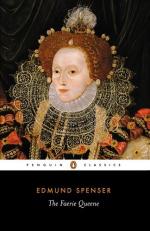“And quite dismembred hath; | the
thirsty land
Dronke up his life; | his corse left on
the strand.” (III, xx.)
The rhythm of the meter is also varied by the alternating of end-stopped and run-on lines, as in the last quotation. An end-stopped line has a pause at the end, usually indicated by some mark of punctuation. A run-on line should be read closely with the following line with only a slight pause to indicate the line-unit. Monotony is prevented by the occasional use of a light or feminine ending—a syllable on which the voice does not or cannot rest; e.g.—
“Then choosing out few words most
horrible.” (I, xxxvii.)
“That for his love refused deity.”
(III, xxi.)
“His ship far come from watrie wilderness.”
(III, xxxii.)
The use of alliteration, i.e. having several words in a line beginning with the same letter, is another device frequently employed by Spenser for musical effect; e.g.—
“In which that wicked wight his
dayes doth weare.” (I, xxxvi.)
“Sweet slombring deaw, the which
to sleep them biddes.” (I, xxxvi.)
5. VERSIFICATION.—In the handling of his stanza, Spenser revealed a harmony, sweetness, and color never before dreamed of in the English. Its compass, which admitted of an almost endless variety of cadence, harmonized well with the necessity for continuous narration. It appeals to the eye as well as to the ear, with its now languid, now vigorous, but always graceful turn of phrase. Its movement has been compared to the smooth, steady, irresistible sweep of water in a mighty river. Like Lyly, Marlowe, and Shakespeare, Spenser felt the new delight in the pictorial and musical qualities of words, and invented new melodies and word pictures. He aimed rather at finish, exactness, and fastidious neatness than at ease, freedom, and irregularity; and if his versification has any fault, it is that of monotony. The atmosphere is always perfectly adapted to the theme.
6. DICTION AND STYLE.—The peculiar diction of the Faerie Queene should receive the careful attention of the student. As a romantic poet, Spenser often preferred archaic and semi-obsolete language to more modern forms. He uses four classes of words that were recognized as the proper and conventional language of pastoral and romantic poetry; viz. (a) archaisms, (b) dialect, (c) classicisms, and (d) gallicisms. He did not hesitate




